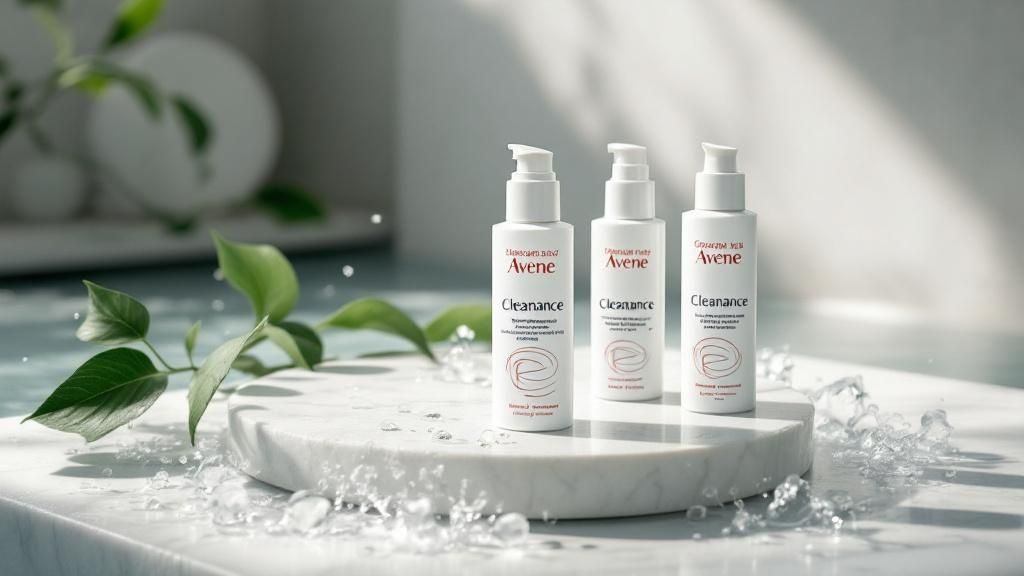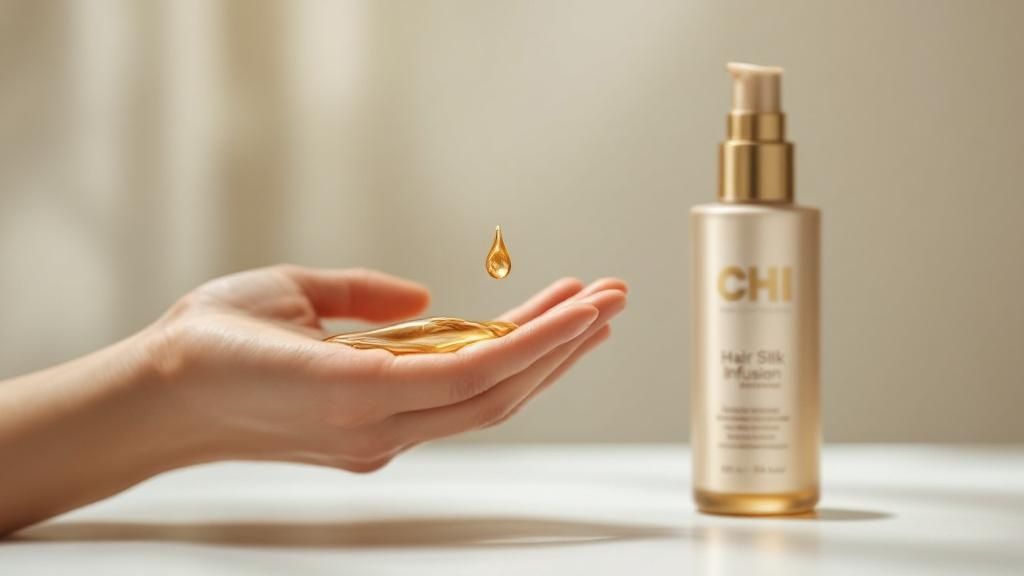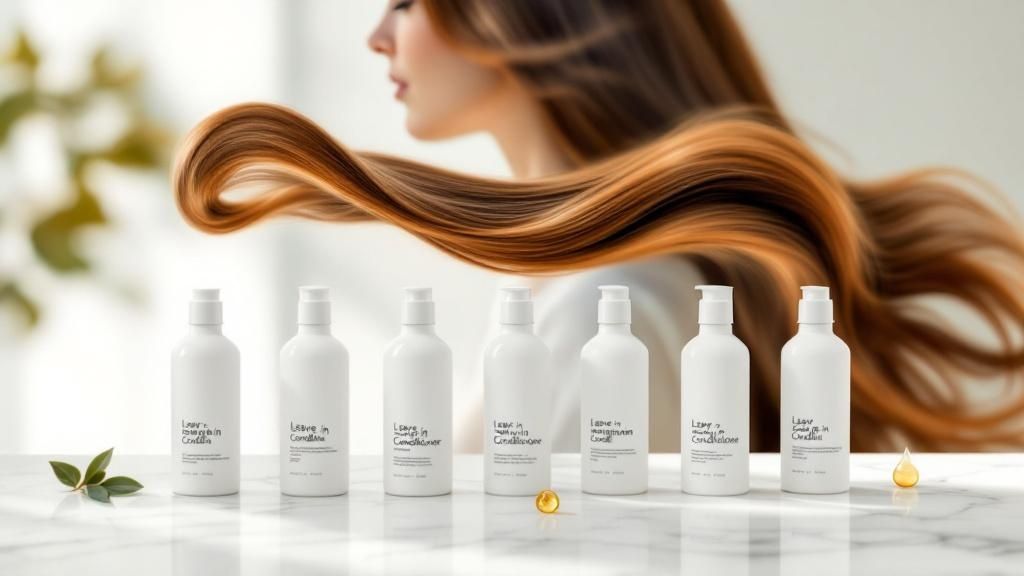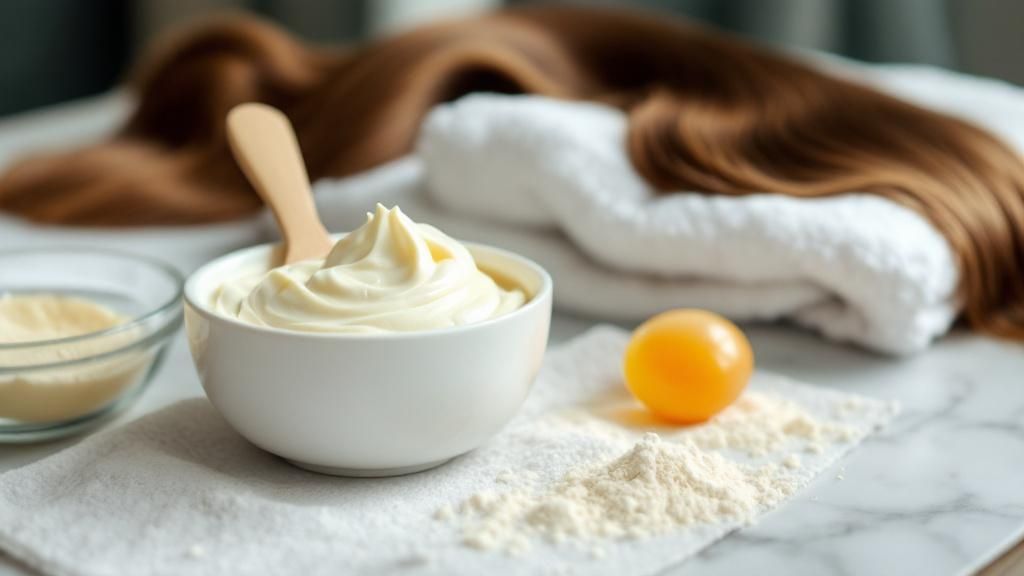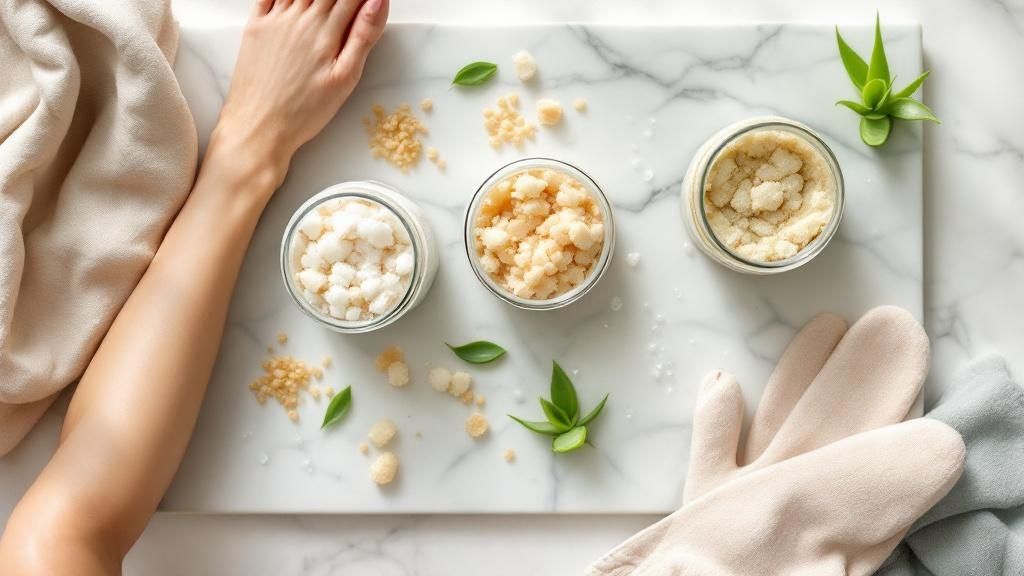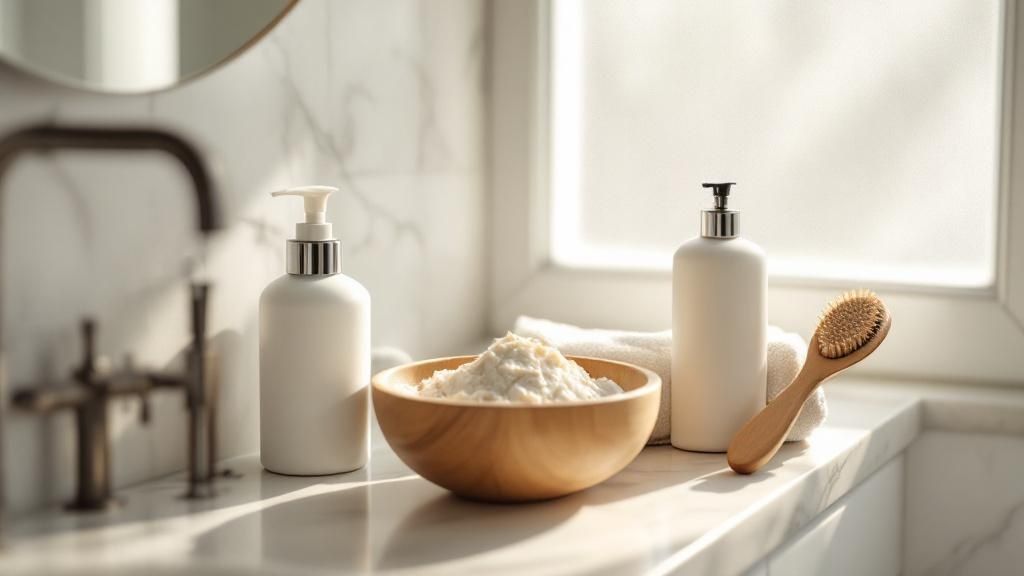
Discover Essential Face Care Routine Steps for Radiant Skin
When you boil it all down, an effective face care routine really only has a few core parts. At its most basic, you’re looking at cleansing to get rid of grime, using a serum to tackle specific issues, and then locking it all in with a moisturiser and, for daytime, sunscreen to hydrate and protect.
Building Your Foundational Skincare Routine
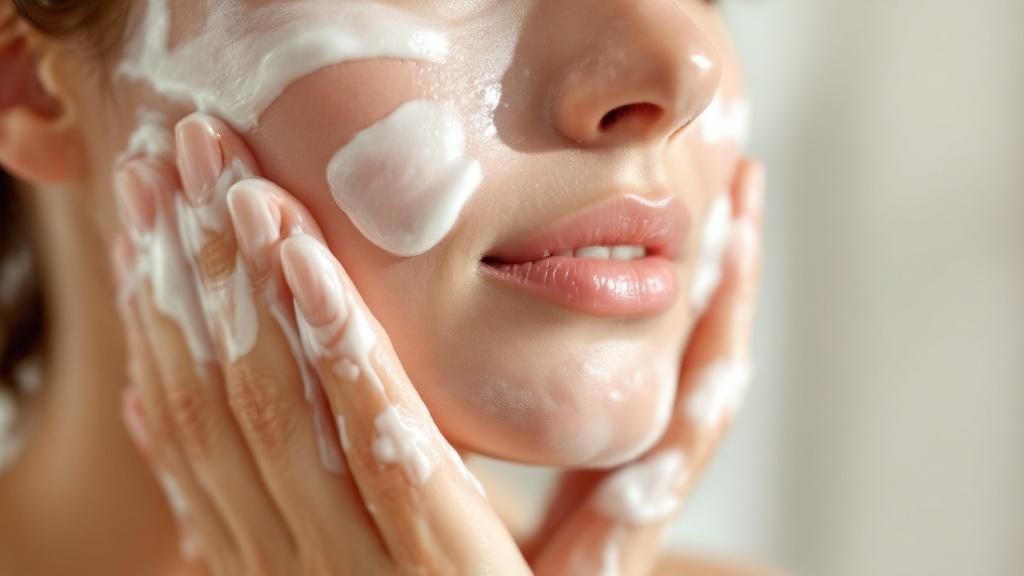
Starting out with skincare can feel overwhelming, but the truth is, a great routine is built on just a few key principles. It's not about having a shelf loaded with products; it’s about consistently using the right products in the right order. This is how you'll truly get the most out of your face care routine steps.
A simple, dermatologist-approved approach breaks it down into three main actions: cleanse, treat, and protect.
I like to think of my routine as having two different, but equally important, jobs. Your morning routine is all about protection, while your evening routine is focused on repair. This simple shift in mindset ensures your skin is getting precisely what it needs, right when it needs it.
Morning Protection vs. Evening Repair
In the morning, your skin’s main job is to defend itself. It’s up against UV rays, pollution, and all sorts of other environmental factors that can speed up the signs of ageing. An antioxidant serum followed by a good broad-spectrum sunscreen is your skin's personal bodyguard.
At night, it's a different story. Your evening routine is your chance to wash away the day and kickstart the skin's natural repair cycle that happens while you sleep. This is the perfect time to bring in your targeted treatments and richer, more nourishing products. Grasping this "protect vs. repair" idea is the first real step to building a routine that actually works.
A truly effective, minimal routine can be just three steps: cleanse, treat, protect. This simple philosophy is all you need to support your skin's natural barrier while tackling your main concerns.
Why The Order of Application is So Important
So, does the order you apply your products really matter? Absolutely. It all comes down to how well your skin can absorb them.
Skincare products are made with different molecular structures and for different purposes. Slapping them on in the wrong order can make them less effective, or worse, completely useless. A classic example is putting a thick, heavy cream on before a lightweight serum. That cream creates a barrier, and the serum's active ingredients simply can't get through to do their job.
As a rule of thumb, always go from the thinnest consistency to the thickest. Think water-based products first, then gels, lotions, creams, and finally, oils. This lets each layer penetrate properly without being blocked by the one before it.
Here in Egypt, our climate adds another layer to this. The intense sun and humidity make proper layering even more crucial. A good local routine almost always includes diligent moisturising and daily broad-spectrum sunscreen to fight off dehydration and sun damage—a perfect example of adapting your routine to your environment. You can see how local climates shape skincare habits in market research on the Egyptian beauty and personal care market.
To keep things simple, here's a quick look at the core steps for your morning and evening routines.
Core Morning vs. Evening Skincare Steps
This table breaks down the non-negotiable steps for both your AM and PM routines, giving you a clear foundation to build upon.
| Routine | Essential Step | Primary Goal |
|---|---|---|
| Morning | 1. Cleanse | Remove sweat and oil from overnight. |
| Morning | 2. Treat (Antioxidant) | Protect against environmental damage (e.g., Vitamin C). |
| Morning | 3. Moisturise | Hydrate and lock in treatments. |
| Morning | 4. Sunscreen | Shield from UV rays. |
| Evening | 1. Cleanse | Remove makeup, sunscreen, and daily grime. |
| Evening | 2. Treat (Actives) | Target specific concerns (e.g., retinol, acids). |
| Evening | 3. Moisturise | Repair and support the skin's barrier while you sleep. |
Think of this table as your basic roadmap. As you get more comfortable, you can start adding or swapping steps like toners or eye creams, but these core actions are where the magic really begins.
Your Morning Ritual for Daily Protection
Think of your morning routine as your skin’s personal shield. Its main job isn’t deep repair; it’s all about arming your skin against everything the day throws at it—UV rays, pollution, and general city grime. This is especially true here in Egypt, where the sun is a constant companion.
A classic mistake I see people make is over-cleansing in the morning. Your skin isn't caked in makeup or dirt from the night before. All you really need is a gentle wash to clear away any sweat and excess oil that built up while you slept. The key is to do this without stripping away the good stuff your skin needs to stay balanced.
Once cleansed, you want to prep your skin for what comes next. This is where a good toner makes all the difference. Forget those harsh, alcohol-heavy formulas from years ago; modern toners are a completely different game. They work to rebalance your skin's pH and get rid of that last little bit of impurity, creating the perfect canvas for your serums.
Infusing Your Skin with Antioxidants
With your skin prepped and ready, it's time to bring in the active ingredients. Mornings are the absolute best time for an antioxidant serum, and when it comes to daytime protection, Vitamin C is the undisputed champion. It’s like a second layer of defence against all the environmental stress that your sunscreen might not catch.
A quality Vitamin C serum gets to work neutralising free radicals—those nasty, unstable molecules that damage skin cells and speed up the signs of ageing. If you use one consistently, you'll start to notice brighter skin and a much more even-toned complexion.
This quick overview gives you the basic flow for a solid, protective morning routine.

As the infographic shows, a simple three-part sequence—cleanse, tone, and moisturise—is the unshakable foundation of any skincare that actually works.
After your serum has had a moment to sink in (give it about 60 seconds), you can move on to the final, crucial steps. For a deeper dive, check out our complete guide to the ideal morning skincare routine steps.
The Two Most Important Final Steps
Now we get to the two non-negotiable pillars of any morning skincare ritual: moisturiser and sunscreen. Honestly, skipping either is like leaving the house without locking the door; you’re just leaving your skin vulnerable.
First up, your moisturiser. This step is vital, even if you have oily skin. A good moisturiser locks in all the hydration from your previous steps and helps strengthen your skin's natural barrier. For daytime, I always recommend a lighter formula that sits comfortably on your skin and won't feel heavy, especially if you plan on wearing makeup.
Pro Tip: Let your moisturiser fully absorb before you even think about putting on sunscreen. Applying SPF to damp skin can dilute its effectiveness and lead to patchy, uneven protection. A little patience here goes a long way.
Finally, we arrive at the most critical step of all: sunscreen. UV exposure is the number one cause of premature ageing, hands down. Protecting your skin every single day is the best anti-ageing strategy you can possibly adopt.
Make sure you're using a broad-spectrum sunscreen with at least SPF 30. "Broad-spectrum" is the magic word here; it means the product protects you from both UVA rays (the ageing rays) and UVB rays (the burning rays). Apply it generously to your face, neck, and any other skin that sees the sun. Remember, consistency is what gets you results. Making these steps a daily habit is the ultimate investment in your skin's long-term health and radiance.
The Evening Routine for Repair and Renewal
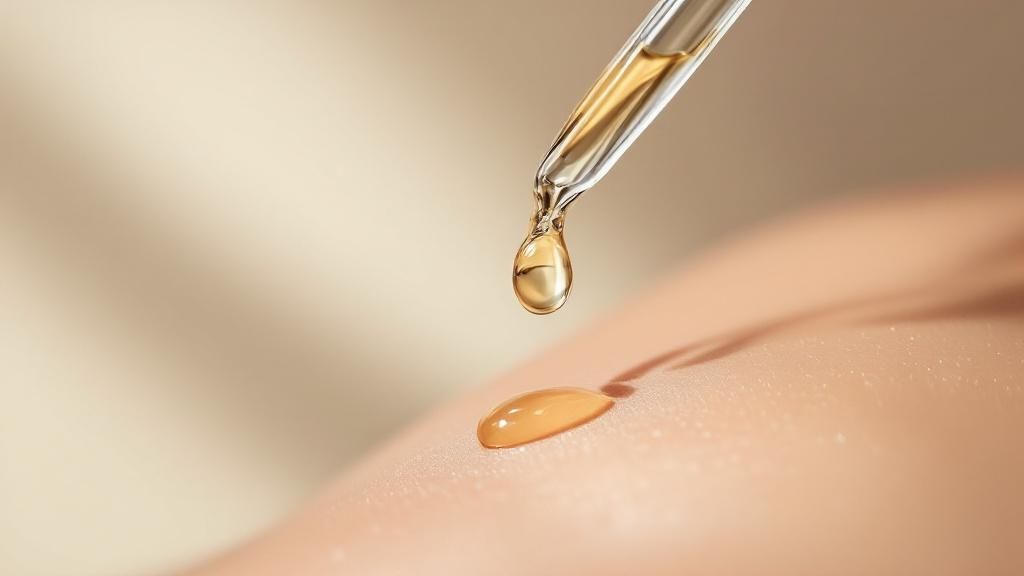
When the sun goes down, your skin’s job description changes completely. All day long it's been in defence mode, shielding you from sun, pollution, and daily grime. But at night, its focus shifts to repair and regeneration. This is when your skin’s natural healing processes kick in, making your evening routine absolutely critical. It’s your chance to wash away the day and apply potent, restorative ingredients that do their best work while you rest.
Unlike your quick morning rinse, your evening cleanse needs to be a bit more thorough. Think about everything your face has been through: layers of makeup, SPF, sweat, and environmental pollutants. A single wash just won't cut it. This is where double cleansing becomes your secret weapon.
The Power of the Double Cleanse
If you're not double cleansing yet, this will be a game-changer. It's a simple, two-step method that ensures you get everything off your skin's surface, preventing clogged pores and allowing your expensive serums to actually do their job.
- First, an Oil-Based Cleanser: Start with an oil cleanser or balm massaged onto dry skin. The oil acts like a magnet, dissolving stubborn, oil-based products like sunscreen, foundation, and even waterproof mascara without any harsh scrubbing.
- Then, a Water-Based Cleanser: After rinsing the oil away, go in with your regular water-based or foaming cleanser. This second step gets rid of any remaining residue, sweat, and water-based dirt.
The result? Your skin is deeply clean but not stripped of its essential moisture. It's the perfect canvas for everything that comes next.
Introduce Targeted Treatments and Exfoliants
With a perfectly clean slate, it’s time to bring in the heavy hitters. Your evening routine is the ideal time to use chemical exfoliants like AHAs (alpha-hydroxy acids) or BHAs (beta-hydroxy acids). These acids gently dissolve the "glue" that holds dead skin cells together, revealing a brighter, smoother complexion hiding underneath.
A word of caution, though: it's easy to overdo it. Over-exfoliating can compromise your skin barrier and lead to irritation. A good rule of thumb is to start with a chemical exfoliant just one to three times per week, and never on the same night as other strong actives like retinol.
On the nights you aren't exfoliating, focus on repair. If your morning serum is for protection, your evening serum is for restoration. This is the moment for ingredients that stimulate cell turnover and kick collagen production into high gear.
Retinol is the gold standard for a reason. It's scientifically proven to improve skin texture, reduce fine lines, and even out skin tone. Peptides are another fantastic choice, working to firm the skin and support its structure.
For a deeper dive into building the ultimate PM regimen, check out our detailed guide on the essential nighttime skincare routine steps.
Lock It All In with a Nourishing Moisturiser
The final, non-negotiable step is to seal in all that goodness with a nourishing moisturiser. Your night cream should be richer and more substantial than your daytime one. Its job is to provide deep hydration and support your skin’s barrier while you sleep.
Look for formulas packed with ingredients like ceramides to replenish your skin's natural building blocks or hyaluronic acid for a serious moisture boost. If your skin is particularly dry, you can even add a face oil as the very last step. Oils are occlusive, meaning they form a protective seal over your skin, preventing water loss and locking in every active ingredient you just applied. You'll wake up to a plump, refreshed, and truly renewed complexion.
Making Your Routine Work for Your Skin
So, you’ve got the basic steps down. That's a fantastic start, but the real magic happens when you start personalising things. Skincare isn't a one-size-fits-all game; what makes one person’s skin glow might not do a thing for yours. The key is to listen to your skin and give it what it’s asking for, whether that's more moisture, less oil, or a gentler touch.
Think of it this way: a good recipe gives you the ingredients and instructions, but a great cook knows when to add a pinch more spice or a little less salt. Your face care routine is the same. Let's look at how to make those little adjustments for your specific skin type.
For Oily Skin: It's All About Balance
If you’re constantly battling shine and breakouts, you know the oily skin struggle is real. The temptation is to use harsh products to dry everything out, but that often backfires, causing your skin to produce even more oil to compensate. The goal isn't to eliminate oil completely, but to bring it into balance.
- Your Cleanser: Ditch the heavy, creamy cleansers. A lightweight gel or gentle foaming wash is your best friend. Look for one with salicylic acid—it’s brilliant at getting deep into your pores to clear out the gunk that leads to blemishes.
- Your Moisturiser: Yes, you still need one! Skipping it is a common mistake that can make oily skin worse. Just choose wisely. An oil-free, non-comedogenic (meaning it won't clog your pores) gel moisturiser will give you the hydration you need without any greasy, heavy feeling.
For Dry Skin: Quench That Thirst
Dry skin often feels tight, can look a bit dull or flaky, and basically just screams out for moisture. Your entire routine should be geared towards hydrating your skin and, just as importantly, locking that moisture in.
Start with a creamy, non-foaming cleanser that cleans your skin without stripping away its natural oils. But the real game-changer? A dedicated hydrating serum.
A serum packed with hyaluronic acid is a must. This incredible ingredient can hold up to 1,000 times its weight in water, pulling moisture deep into your skin cells. Always apply it to damp skin and follow up immediately with a thicker, ceramide-rich moisturiser to seal everything in and repair your skin’s protective barrier.
For Combination Skin: The Art of "Zoning"
Got an oily T-zone but dry or normal cheeks? Welcome to the combination skin club. It can feel a bit confusing, but the solution is actually quite simple: treat different parts of your face differently. This is sometimes called "zoning."
It just means you might use a lightweight, balancing moisturiser on your forehead, nose, and chin, but a richer cream on your cheeks where you need more hydration. You could also apply a clarifying clay mask only to your T-zone once a week to manage oil without drying out the rest of your face. It requires a little extra thought, but your skin will thank you for the targeted care.
This desire for personalised care is catching on. In fact, a recent report showed that 73% of Egyptian consumers are willing to spend more on personal care products with natural ingredients. It’s clear that people want formulas that are not just effective, but also thoughtfully made. You can dig deeper into these insights in the Egyptian skincare market report.
For Sensitive Skin: Less is More
If your skin gets red, itchy, or irritated easily, you've got sensitive skin. Your guiding principle should be "less is more." A simple, gentle routine is the best way to keep your skin calm and happy.
Make it a habit to check labels for products that are fragrance-free, as synthetic fragrances are one of the most common triggers for irritation. Calming ingredients like niacinamide (a form of vitamin B3) and centella asiatica (often called cica) are fantastic for reducing redness and strengthening your skin’s barrier. And remember the golden rule: always patch-test a new product on a small, hidden area of skin before slathering it all over your face.
To help you find the right fit, here's a quick guide to what you should be looking for based on your skin type.
Product Recommendations by Skin Type
This table breaks down the key ingredients and textures to look for when building a routine that's perfectly suited to your skin's needs.
| Skin Type | Key Cleanser Ingredient | Ideal Serum Ingredient | Moisturiser Texture |
|---|---|---|---|
| Oily | Salicylic Acid | Niacinamide | Gel or Oil-Free |
| Dry | Ceramides | Hyaluronic Acid | Rich Cream |
| Combination | Gentle Surfactants | Antioxidants | Lightweight Lotion |
| Sensitive | Glycerine | Centella Asiatica (Cica) | Calming Cream |
Using this as a starting point, you can confidently choose products that will work with your skin, not against it, helping you achieve that healthy, balanced complexion you're aiming for.
Common Skincare Mistakes You Might Be Making
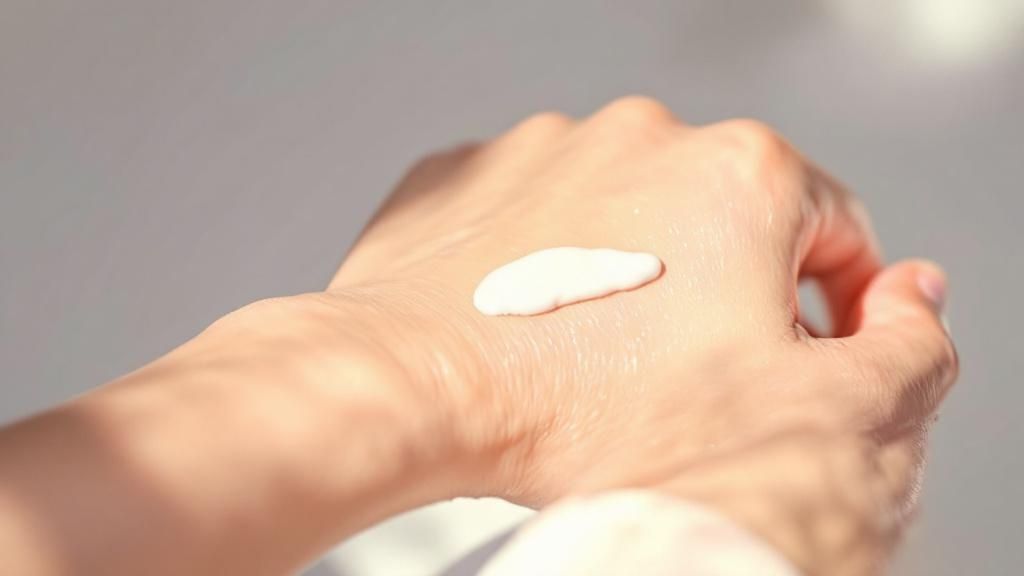
It’s a frustrating feeling: you’ve invested in fantastic products, but your skin still isn't cooperating. If this sounds familiar, don’t worry. It often comes down to a few common habits that can accidentally sabotage all your hard work.
Learning to spot these little missteps is a huge part of refining your face care routine steps and finally getting the results you’re looking for.
One of the biggest culprits I see is over-exfoliating. We all want that smooth, glowing look, and it’s tempting to think that more scrubbing or more acids will get us there faster. The reality is, going too hard can strip your skin’s natural protective barrier. This leads to that dreaded trio: redness, sensitivity, and that tight, uncomfortable feeling.
The Myth of Skipping Moisturiser
I hear this all the time, especially from clients with oily or acne-prone skin: "I skip moisturiser because it makes me greasy." This is probably the most widespread skincare myth out there.
Here’s what actually happens: when you deprive your skin of moisture, it goes into survival mode. It overcompensates by producing even more oil to hydrate itself, which can clog pores and lead to more breakouts. It's a vicious cycle.
The key isn't to skip this crucial step, but to find the right moisturiser. A lightweight, oil-free, or gel-based formula will deliver the hydration your skin needs to feel balanced, without adding any heaviness. If you're struggling with breakouts, our dedicated guide to skincare for acne-prone skin is packed with targeted advice.
"I often remind my patients that more isn’t always better. The optimal simplified skin-care routine is one that supports your skin’s natural barrier while addressing your core needs and nothing more."
This really gets to the heart of it. Your skin barrier is your first line of defence. Overwhelming it with harsh products or skipping essential steps like moisturising will only leave it compromised.
Other Common Routine Pitfalls
It's not always about what you use, but how you use it. Sometimes, small application errors are the real reason you're not seeing progress. Let’s see if any of these sound familiar.
- Applying products out of order: Think of it like trying to put on your shirt after your jacket. Slathering a thick cream on before a lightweight serum essentially blocks the serum's active ingredients from ever reaching your skin. A golden rule to live by: always apply your products from the thinnest consistency to the thickest.
- Forgetting your neck and chest: The skin on your neck and décolletage is just as delicate as on your face—and it often shows signs of ageing just as quickly. Make it a habit to extend every step of your routine all the way down.
- Lacking consistency: Great skin is a long-term commitment, not a one-night stand. It takes at least one full skin cycle (about 30 days) to even begin to see noticeable changes from a new routine. Skipping days or giving up too soon means you'll never reap the rewards.
- Expecting overnight miracles: We all want instant gratification, but effective skincare simply doesn't work that way. Potent ingredients need time to do their job. Be patient and stick with it.
Got Questions About Face Care? We’ve Got Answers.
Diving into a new skincare routine always brings up a few questions. Getting straight answers is the best way to build a routine you actually trust and stick with. Let's break down some of the most common things people wonder about when they're sorting out their face care routine steps.
How Long Should I Wait Between Applying Products?
This is a great question, and the answer is all about patience. A good rule of thumb is to give it about 60 seconds, or just until a product doesn't feel wet anymore before you reach for the next bottle. I find this is especially important when I'm using serums packed with active ingredients—you want to give them a real chance to sink in before layering a moisturiser on top.
With sunscreen, though, waiting is non-negotiable. If you slather it onto damp skin, you risk diluting the formula and messing up the even, protective layer you’re trying to create. Rushing can also cause products to "pill" (those annoying little balls that roll up on your skin), which basically means your routine isn't working as well as it should.
Do I Really Need a Separate Morning and Evening Routine?
Yes, you really do. Think of it this way: your morning and evening routines have completely different jobs.
-
Your Morning Routine: This is your skin's defence squad. Its entire purpose is to protect your skin from things like sun damage and pollution as you go about your day. That’s why you’ll see antioxidants like Vitamin C and, of course, sunscreen in a solid AM routine.
-
Your Evening Routine: This is your repair crew. Once you've cleansed the day away, you’re free to use ingredients that get to work while you sleep. Things like retinoids or exfoliating acids are perfect for nighttime because they can focus on restoring and rejuvenating your skin, safely away from the sun.
Remember, consistency is everything. It usually takes a full skin cycle—about 30 to 45 days—to really see a difference in your skin's texture or clarity. For anti-ageing results from ingredients like retinol, you're looking at a longer game of three to six months of steady use.
What if I'm Too Tired to Do My Full Routine?
We've all been there. On those nights when you're just wiped out, don't throw in the towel completely. Just aim for the "skincare minimum."
For your evening routine, that means, at the very least, washing your face to get rid of makeup, SPF, and the day's grime, and then popping on a simple moisturiser. This quick two-step move is enough to prevent clogged pores and keep your skin barrier happy.
And in the morning? The one step you should never, ever skip is sunscreen. UV damage is the biggest culprit behind premature ageing, and it happens even on cloudy days or when you're just sitting by a window.
Ready to build a routine that truly works for you? Discover authentic, targeted solutions for every concern at lo.la, where you can find everything from gentle cleansers to powerful serums. Explore the perfect products to elevate your face care routine steps today at https://www.lolabeautyshop.com.










